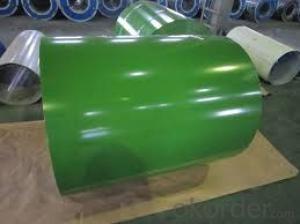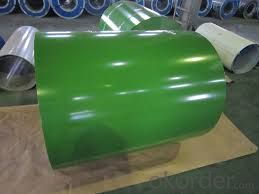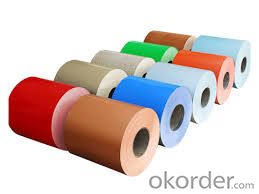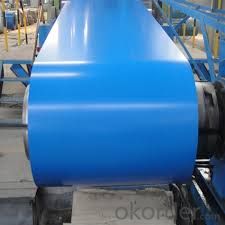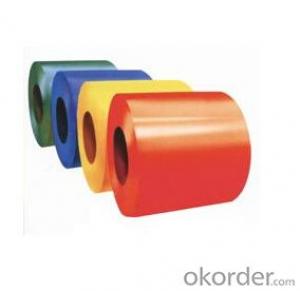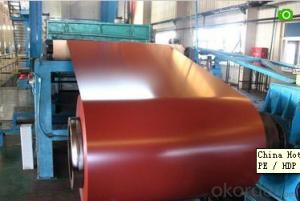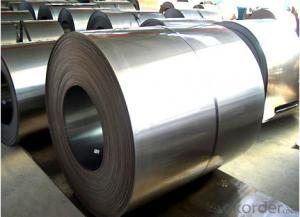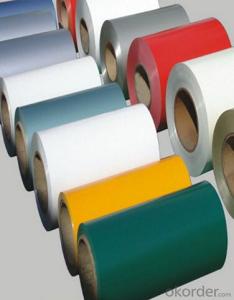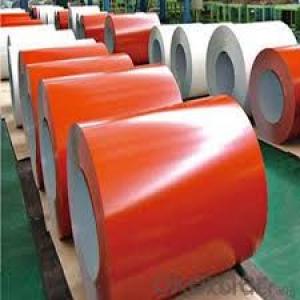Prepainted Steel Coil PPGI ((0.16-1.2)*(900-1250))
- Loading Port:
- Shanghai
- Payment Terms:
- TT OR LC
- Min Order Qty:
- 25 m.t.
- Supply Capability:
- 10000 m.t./month
OKorder Service Pledge
OKorder Financial Service
You Might Also Like
Product Description
We are specialized in types of hot dipped galvanized, galvalume, prepainted steel products, corrugated steel sheet, etc.
Poduce Name: Prepainted Hot Dipped Steel Coil
Standard: JIS G3302, JIS G3312, ASTM A653M/A924M 1998
Grade: Q195 - Q235 and 08AL, SPCC, SPCD, SPCE, 08.10.15, SGCC (DX51D+Z) SGCD(DX52D+Z) etc.
Surface treatment: Chromated, unoiled/oiled, bright finished, spangle, fingerprint resistance.
Surface protection: PE, PVDF, SMP, HDP, etc.
Thickness: 0.20mm-2.0mm
Width: 1000mm, 1200mm, 1250mm, 1500mm, or according to your request.
Zinc coating: 80g-275GSM
Coil weight: 3-27 tons
Paint: Polyester silicon modified polyester, PVC sol, polyvinylidene chloride
Colour: RAL, or other series.
Application:
Architectural applications: Outdoor construction: Roof, the roof structure, balcony panels, water downpipe, window frames, gates, garage doors, roller shutter doors, kiosks, shutters, guard room, shower enclosure, refrigerated trucks and so on.
Indoor applications: Door, partitions, door frames, housing, light steel structure, sliding doors, screens, ceilings, bathroom interior, the elevator built, the elevator vestibule and so on.
Electrical Appliances: Refrigerators, frozen food display cabinets, washing machines, electric ovens, vending machines, air conditioners, copiers, switchgear, instrument cabinets, electric fans, vacuum cleaners and so on.
Transport: Car ceiling, backplane, hoardings, interior trim panels, car shell, trunk panels, car dashboard, console shell, tram, train ceiling, partitions, wall, door, ships separated Swatchesdoors, furniture board, flooring, container, etc.
Sheet metal processing and furniture applications: Ventilation and heating stoves, water heaters, shell, counters, shelves, signs, wardrobe, desk, bedside cabinets, chairs, lockers, file cabinets, bookshelves.
Exact Rate As Per Your Request.
| Color coated similar grades comparison table | |||||
| JISG 3312-1994 | |||||
| Q/BQB 440-2003 | |||||
| TDC51D(TSt01,TSt02,TSt03) | CGCC | ||||
| TDC52D | CGCD1 | ||||
| TDC53D | - | ||||
| TS280GD(TStE28) | CGC400 | ||||
| TS350GD(TStE34) | CGC440 | ||||
| TS550GD | CGC570 | ||||
| TSECC ,TBLCE | - | ||||
| TSECD ,TBLDE | - | ||||
| TSECE ,TBUSDE | - | ||||
| Q/BQB 445-2004 | AS 2728-1997a(AS 1397-2001) | JISG 3322-1998 | |||
| TDC51D+AZ | (G2+AZ) | CGLCC | |||
| TDC52D+AZ | (G3+AZ) | CGLCD | |||
| TS250GD+AZ | (G250+AZ) | - | |||
| TS300GS+AZ | (G300+AZ) | - | |||
| TS350GD+AZ | (G350+AZ) | CGLC490 | |||
| TS550GD+AZ | (G550+AZ) | CGLC570 | |||
| The coating surface structure classification | |||||
| classification | item | code | |||
| application | Building Exterior | JW | |||
| Building inside | JN | ||||
| Steel window | GC | ||||
| Household electrical appliances | JD | ||||
| funiture | JJ | ||||
| others | QT | ||||
| Coated surface state | Coating plate | TC | |||
| Embossing plate | YA | ||||
| Printing plate | YI | ||||
| Paint types | polyester | PE | |||
| Silicone modified polyester | SMP | ||||
| Poly vinylidene fluoride | PVDF | ||||
| Substrate types | Galvanized sheet | DX | |||
| Hot galvanized plate | Finishing zinc flower | ||||
| Spangle | |||||
| Coating structure | Upper surface | First coating | |||
| two coating | First coating | ||||
| two coating | two coating | ||||
| Supplier standards and grades | |||||
| The Grades and use of color coated sheet | Grades, standards and types of substrate | ||||
| Grades | applications | Grades | standards | type | |
| TDC51D | General use | DC51D+Z | Q/BQB 420 | Hot galvanized plate | |
| TDC52D | Stamping | DC52D+Z | |||
| TDC53D | deep Stamping | DC53D+Z | |||
| TS280GD | Structure | S280GD+Z | |||
| TS350GD | Structure | S350GD+Z | |||
| TS550GD | Structure | S550GD+Z | |||
| TSECC | General use | SECC | Q/BQB 430 | Galvanized sheet | |
| TSECD | Stamping | SECD | |||
| TSECE | deep Stamping | SECE | |||
| TBLCE | General use | BLCE+Z | |||
| TBLDE | Stamping | BLDE+Z | |||
| TBUSDE | deep Stamping | BUSDE+Z | |||
| TDC51D+AZ | Cold forming | DC51D+AZ | Q/BQB 425 | Hot dip aluminized zinc plate | |
| TDC52D+AZ | Cold forming | DC52D+AZ | |||
| TS250GD+AZ | Structure | S250GD+AZ | |||
| TS300GD+AZ | Structure | S300GD+AZ | |||
| TS350GD+AZ | Structure | S350GD+AZ | |||
| TS550GD+AZ | Structure | S550GD+AZ | |||
| Available specification range | |||||
| Item | Nominal Size | ||||
| Nominal thickness | 0.22-1.30 | ||||
| Nominal width | 700-1250 | ||||
| nominal length of steel plate | 1000-4000 | ||||
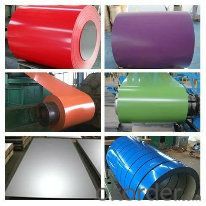
FAQ
1. Is the sample available?
Yes, samples can be sent for test if you need.
- Q: I'm looking to buy the Milano Stiletto, and it uses 1045 steel. I was just wondering whether this will hold up and keep an edge.
- C1045 Steel
- Q: How do steel coils contribute to energy efficiency in appliances?
- There are several ways in which steel coils enhance energy efficiency in appliances. First and foremost, steel coils are extensively utilized in the heat exchangers of appliances like refrigerators, air conditioners, and water heaters. These coils effectively transfer heat, enabling appliances to cool or heat the desired space using less energy. By maximizing heat transfer, steel coils aid appliances in reaching the desired temperature faster and maintaining it with minimal energy consumption. Additionally, steel coils are commonly employed in the heating elements of appliances such as stoves and ovens. These coils directly provide heat for cooking or baking food. Steel's exceptional thermal conductivity ensures the even distribution of heat, reducing both cooking time and energy usage. This enables appliances to operate more efficiently, resulting in time and energy savings. Moreover, the durability and longevity of steel coils contribute to energy efficiency in appliances. Appliances equipped with steel coils are designed to withstand high temperatures and frequent usage. Consequently, they require less maintenance and replacement, reducing the consumption of resources needed to manufacture new appliances. By diminishing waste and conserving resources, steel coils indirectly promote energy efficiency and sustainability. Lastly, steel is a recyclable material. When appliances reach the end of their life cycle, the steel coils can be recycled and utilized in the production of new products. Recycling steel diminishes the necessity for extracting raw materials and conserves energy that would otherwise be utilized in the manufacturing process. This fosters energy efficiency and diminishes the environmental impact of appliances. In conclusion, steel coils contribute to the energy efficiency of appliances by optimizing heat transfer, reducing cooking time, promoting durability, and facilitating recycling. These factors collectively enhance the operational efficiency of appliances, conserve energy, and contribute to a more sustainable future.
- Q: What are the limitations of using steel coils in certain applications?
- One limitation of using steel coils in certain applications is their susceptibility to corrosion. Steel coils can rust when exposed to moisture or harsh environments, which can affect their structural integrity and performance. Additionally, steel coils can be heavy and bulky, making them less suitable for applications that require lightweight materials or intricate designs. Finally, steel coils may not be suitable for applications that require specific electrical or thermal conductivity properties, as steel is not the most conductive material in these aspects.
- Q: Are steel coils used in furniture manufacturing?
- Yes, steel coils are commonly used in furniture manufacturing for various purposes such as providing support and stability to seating structures, enhancing durability, and ensuring proper weight distribution.
- Q: What are the different methods of testing the mechanical properties of steel coils?
- There are several methods for testing the mechanical properties of steel coils. Some commonly used methods include tensile testing, hardness testing, impact testing, and bend testing. Tensile testing measures the strength and ductility of the steel by applying a tensile force until it breaks. Hardness testing determines the resistance of the steel to indentation or scratching. Impact testing measures the ability of the steel to withstand sudden forces or shocks. Bend testing evaluates the flexibility and resistance to cracking of the steel by bending it to a specific angle. These methods help assess the quality and performance of steel coils in various applications.
- Q: How are steel coils used in the manufacturing of electrical appliances?
- Steel coils are used in the manufacturing of electrical appliances as they serve as the core component for transformers and inductors. These coils are wound with copper wire and encased in a steel core to efficiently transfer electrical energy. The steel coils provide stability, durability, and magnetic properties necessary for the proper functioning of electrical appliances.
- Q: If you were selecting a tool steel for an extreme impact load application, which one would you pick? why?thanks
- It all depends what the application actually is. For hammers I would select a hammer grade B1 steel. For impact loading where an edge is needed I would be going for O1 or similar (oil quenching steels tend to be a little tougher than air hardening). For mining tools a very high manganese steel (Hadfields steel) - this is not a true tool steel. The best place to start is by looking at the ranking of the properties which you want - hardness v toughness v strength - and then use this to put the steels in rank order. Price and availablity then sort the problem out for you (in the real world).
- Q: I personally don't believe the story of 8 guys who flew small planes can navigate passenger jets into buildings hundreds of miles away with that precision. It just doesn't make sense.I am wondering what the story surrounding the molten steel was, how could molten steel have been produced when fuel from the planes wasn't hot enough (it melts at 2850 degrees)?
- that's just it: there wasn't very much molten steel for the very reason you point out. Jet fuel burns at 800° to 1500°F. This is not hot enough to melt structural steel. However, engineers say that for the World Trade Center towers to collapse, their steel frames didn't need to melt, they just had to lose some of their structural strength. Steel will lose about half its strength at 1,200 degrees F. The steel will also become distorted when heat is not a uniform temperature. after the collapse, a LOT of folks took a look at the remains. the result was the conclusion that the fire caused the central core of the building to weaken. When the floors collapsed one on top of the other, the weight was too much for the weaked core to bear, causing the result we are all familiar with. hope this helps
- Q: What are the different methods of coil packaging for steel coils?
- Steel coils can be packaged using various methods, each with its own advantages and suitability for specific applications. Some commonly used methods include: 1. Strapping: Steel or plastic strapping is used to secure the coil and prevent unwinding or shifting during transportation. Strapping can be done manually or with strapping machines, providing a reliable and cost-effective packaging solution. 2. Stretch wrapping: This method involves tightly wrapping the coil with a stretch film. The film is stretched and wrapped around the coil, offering protection against dust, moisture, and damage. Stretch wrapping is suitable for lightweight coils and provides good visibility of the product. 3. Steel banding: This robust and heavy-duty method uses steel bands to secure the coil. It ensures high strength and durability, keeping the coil intact during transportation or storage. 4. Edge protectors: To safeguard the edges of the coil, edge protectors made of cardboard or plastic are used in combination with other packaging methods. These protectors provide additional support to prevent edge damage. 5. Wooden crates: For heavy or fragile steel coils, wooden crates are often used to provide maximum protection. The coils are placed inside the crate and secured with strapping or steel banding. Wooden crates offer excellent strength, stability, and can be customized to fit specific coil dimensions. 6. Paper interleaving: This method involves inserting layers of paper or cardboard between individual wraps of the coil to prevent scratching or marking. Paper interleaving is commonly used when stacking coils or when protecting a high surface finish. 7. Automated packaging systems: In larger-scale operations, automated packaging systems can be used. These systems are designed to handle and package coils using various methods such as strapping, stretch wrapping, or steel banding. They ensure increased efficiency, productivity, and consistent and secure packaging. The choice of coil packaging method depends on factors including coil size and weight, transportation requirements, required level of protection, and cost considerations. It is crucial to select the appropriate packaging method to ensure the safe delivery of steel coils to their destination.
- Q: What brand steel tapes are of good quality?
- Personal feeling is also good for the Great Wall Seiko tape, upstairs several estimates are the production of steel tape manufacturers, of course, that their goods well. Our unit now buy all the Great Wall Seiko goods, said the tape is good, not because it is so durable
Send your message to us
Prepainted Steel Coil PPGI ((0.16-1.2)*(900-1250))
- Loading Port:
- Shanghai
- Payment Terms:
- TT OR LC
- Min Order Qty:
- 25 m.t.
- Supply Capability:
- 10000 m.t./month
OKorder Service Pledge
OKorder Financial Service
Similar products
Hot products
Hot Searches
Related keywords
